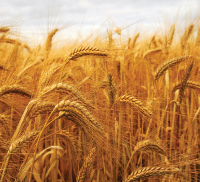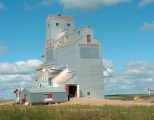
No Escape From Grain Prices: Next year will bring little, if any, letup
Jim Knisley
Features Business & Policy Farm BusinessNext year will bring little, if any, letup
High grain prices are traditionally the cure for low grain supplies.
High grain prices are traditionally the cure for low grain supplies.
High prices convince farmers to plant and produce whatever is in short supply and high prices reduce and shift consumption to more plentiful, lower-cost alternatives.

|
| RUNNING ON EMPTY Canadian Wheat Board analyst David Boyes recently told Manitoba farmers that world wheat demand has exceeded supply for five of the last seven years and supplies are expected to remain tight, despite expectations of more wheat production next year. |
In recent decades, one growing season was usually enough time to pump up supplies and slap down prices.
But this time is different.
If it’s a grain or an oilseed, supplies are tight and prices are way up. It has put growers in a comfortable quandary. They can plant just about anything and be assured a price that would have been unimaginable two years ago.
For buyers and consumers there is no escape. The price of whatever they want to use as a substitute is almost as high as what they are fleeing and supplies are almost as tight and next year will bring little, if any, letup.
The situation for high-quality milling wheat is especially critical. Spot prices in Minneapolis were running over $20 a bushel and have been as high as $25.
Canadian Wheat Board analyst David Boyes recently told Manitoba farmers that world wheat demand has exceeded supply for five of the last seven years and supplies are expected to remain tight despite expectations of more wheat production next year.
“Essentially we are running on fumes right now,” he said in a report in the Manitoba Co-operator.
The wheat situation is so tight that Husky Energy, the operator of two ethanol plants in Western Canada, has decided to replace feed wheat as its dominant feedstock and use corn. The company said there is very little feed wheat available and the wheat that is available is costing about 20 per cent more than corn.
But how long that can last is an open question.
The USDA is projecting a four per cent decrease in corn planting this spring, a 12 per cent increase in soybean planting and a slight increase in wheat acres.
Last year the U.S. seeded more acres to corn than in any year since the Second World War and corn prices still rose.
A reflection of the volatility can be seen with China. It had been a corn exporter, but recently decided to suspend corn exports and stop building corn ethanol plants, which were taking an increasing share of its harvest.
The move by China is designed to avoid high-priced imports.
However, China, which is already far and away the world’s largest importer of soybeans, is expecting to import more in the future because of the country’s inability to increase its own production.

The unprecedented volatility has pulled in and let go tens of billions of speculative dollars looking to escape collapsing U.S. real estate markets, sagging stock markets and fragile investment banks, adding froth to the bubbling commodity market.
Looking ahead, grain users face few knowns and many unknowns.
Meanwhile forecasters have read the tea leaves, pondered the crystal ball and issued their initial projections for 2008 seeding.
Agriculture and Agri-Food Canada expects the area seeded to wheat to be up about 11 per cent from last year. It also forecast a drop in corn acreage and smaller increases in canola and barley area.
The increase in wheat seeding is the result of record high prices, especially for the high protein wheat and durum that Canada specializes in and low carryover stocks from the current crop year.
The area seeded to all types of wheat is expected to hit 24.216 million acres, up from 21.866 million seeded in the spring of 2007. Durum seeding will jump to 6.178 million acres up from 4.816 million acres seeded to durum in 2007.
Canola area is forecast to rise slightly to 14.888 million acres compared with 14.727 million acres seeded in 2007.
Barley acreage is forecast at 10.922 million acres up from 10.865 million in 2007.
Corn area is expected to drop almost 13 per cent to just over 3.0 million acres from 3.44 million in 2007.
Soybeans are expected to be seeded to 3.015 million acres compared to 2.92 million last year.
Canadian producers were expected to decrease the area in oats to 4.991 million acres from 5.407 million seeded in 2007, Agriculture Canada said.
With reasonable weather and average yields, supplies of wheat are expected to return, but the Canadian Wheat Board’s first pool return outlook for 2008 calls for continuing high prices. Prices for corn, soybeans, canola and barley are also expected to remain strong.
Meanwhile the USDA’s Interagency Commodity Estimates Committees for Wheat, Feed Grains, Rice, and Oilseeds is forecasting record average prices in 2008/09 for wheat, corn, and soybeans. The high prices are “driving prospects for combined acreage for the three major field crops to the highest level since the mid 1980s,” the USDA said.
For wheat the USDA expects more seeded acres and lower exports. This should allow the U.S. to have ending stocks well above the historic lows of this year.
Total wheat area in 2008 is expected to increase 3.6 million acres to 64 million. Winter wheat area is up 1.6 million acres and spring wheat (including durum) is expected to gain 2.0 million acres. Wheat production in 2008 is expected to increase 13 per cent to 2,330 million bushels, driven by higher harvested area and a rebound to trend yields.
Production of all five classes of wheat is expected to rise, with nearly two-thirds of the increase in soft red winter due to much larger planted area. Total U.S. supplies in 2008/09 are expected to be up just three per cent over last year because of low carryover. The U.S. is expected to increase imports of high protein milling wheat from Canada, the USDA said.
The USDA cautions that its forecast is very sensitive to weather problems affecting yields.
U.S. wheat use is expected to increase six per cent in 2008/09, with most of the rise coming from increased feeding.
“Although wheat prices will be historically high, cash prices for wheat relative to corn will be lower both this summer and for the marketing year, making wheat feeding more attractive,” the USDA said.
Internationally, high prices have encouraged expanded winter wheat area across Europe and the former Soviet Union. Production in Australia is also expected to recover from droughts during the past two years. World wheat production can be expected to reach a new record high in 2008/09, the USDA said.
While corn plantings are expected to decline this year, they will remain at historically high levels.
United States corn acreage for 2008 is expected to decline 3.6 million acres from 2007. But at 90 million acres, corn plantings would still be the second highest since 1944.
Meanwhile corn prices have risen steadily in the U.S. since early October with cash prices up nearly $2.00 per bushel during that time and new-crop futures up nearly $1.50 per bushel. New-crop futures prices have consistently traded above $5 per bushel US since the beginning of January, more than $1 higher than last year.
Corn production is projected at 12,810 million bushels, down 264 million bushels from last year, but still the second highest on record by more than one billion bushels.
Total corn use is expected to increase only 0.5 per cent in 2008/09 as lower feed and residual use and exports mostly offset the rise in ethanol use.
However the stocks-to-use ratio for 2008/09 is projected at 9.5 per cent, down for a fourth straight year and below the 11.1 per cent projected for 2007/08. The tightening of stocks relative to use mostly reflects growth in ethanol production.
The average price to U.S. corn farmers is projected at a record $4.60 per bushel, up $0.60 from the mid-point of the 2007/08 forecast.
But unlike last year corn has competition this year. Last year gains in corn values far outpaced those for soybeans, but this year new-crop futures for the two commodities have generally moved higher together since fall, according to the USDA.
Soybean plantings are expected to make a comeback because of higher expected returns compared to last year. Soybean supplies, however, are projected lower with sharply lower carryin, the USDA said.
United States soybean area is projected to rise to 71 million acres in 2008, up 7.4 million from last year. Increased area is expected to come from reduced corn and cotton plantings, as well as from more double cropping.
Soybean supplies for 2008/09 are projected at 3,116 million bushels, down two per cent from 2007/08 as sharply lower beginning stocks more than offset increased production. Soybean production for 2008 is projected at 2,950 million bushels, 14 per cent above last year’s crop based both on increased area and a higher yield.
Despite record soybean prices, soybean area will not reach the 2006 record due to strong prices for feed grains, wheat, and other oilseeds, including sunflower seed and canola, the USDA said.
The average U.S. farm price for soybeans is projected at a record $11.50 per bushel, up from $10.40 per bushel in 2007/08.
Tighter global oilseed stocks, strong corn and wheat prices, record vegetable oil prices and high soybean meal prices are expected to support their record price levels for soybeans in 2008/09, according to the USDA.
Print this page